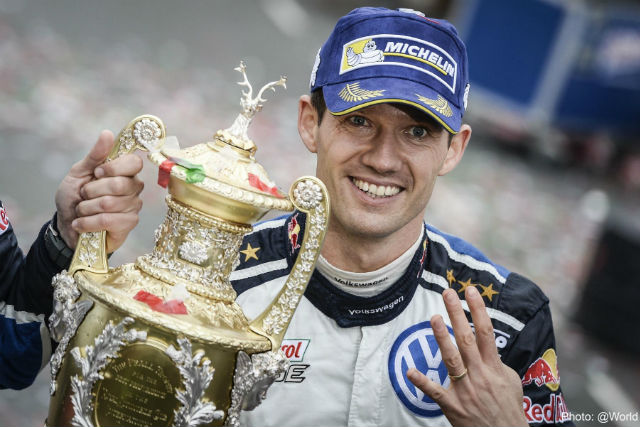One of the world's fastest, most dynamic and most dangerous sports is about to get a lot faster, a lot more dynamic and potentially a lot more dangerous.
Things aren't due to kick off until early next year, but there's plenty of information out there already about what to expect. Here's all you need to know about the 2017 World Rally Championship, from the new cars to the new rules and how you can get in on the action for yourself.
What is it?
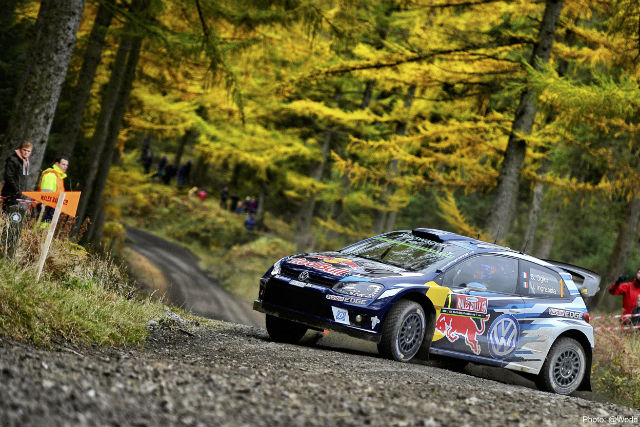
The 2017 World Rally Championship will be the 45th season of the WRC, a racing championship organised by the Fédération Internationale de l'Automobile (FIA) as the highest class of international rallying.
Rally pits teams composed of drivers, co-drivers and support crew against each other in timed sprints across sections of closed public roads known as special stages. Rally is widely regarded as one of the most challenging motorsports due to the unique terrain that the drivers and cars must tackle.
Unlike circuit racing with its perfectly-maintained tarmac tracks, rally drivers must be prepared to drive on gravel, ice, snow, mud, tarmac and more – often all within the same event. As well as that, the drivers essentially drive blind with only the co-drivers’ instructions to point them in the right direction.
Whereas a Formula One driver will see the same ten corners a thousand times, a rally driver will see a thousand corners only once, and will have only one opportunity to get them right. As a result, rally drivers are regarded as some of the best in the world and the WRC features the best of the best competing against each other in one of the world’s most exciting and high-octane competitions.
What’s new for 2017?
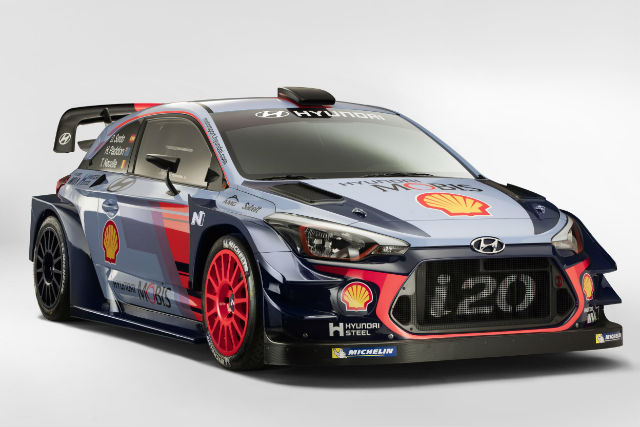
The 2017 season will see the introduction of a significant new ruleset, designed specifically to invoke memories of the iconic ‘Group B’ era of the mid-1980s, a time when rally teams were allowed to design cars with almost limitless power levels.
Group B cars, which included iconic machines like the Audi Quattro and Peugeot 205 T16, were more powerful and faster than F1 cars of their day and sported huge wings, spoilers and scoops and the 80s is widely regarded as rallying’s greatest era.
As a result, the 2017 cars will be allowed much more freedom in their design. Maximum power is due to increase from around 300bhp to 380bhp, weight will drop from 1,200kg to 1,175kg and manufacturers will be allowed a full 55mm extra to work with for larger bumpers, wings and wheel arches.
As well as that, 2017 will see the return of two successful rally teams that have been absent in recent years. Toyota will return to the WRC for the first time since 1999, while Citroen will also now race full-time after taking a year out in 2016 to develop its new car.
On the other side of the coin, reigning champions Volkswagen announced just recently that they will pull out of the championship after four years spent undefeated, a move which has thrown the series into turmoil but which should make for some exciting action as teams scrabble to claim the now-vacant top spot.
Which teams will be competing?
Our three crews line up alongside the Hyundai i20 Coupe #WRC #HyundaiWRC #WRC2017 pic.twitter.com/sbfInuWF8p
— Hyundai Motorsport (@HMSGOfficial) December 1, 2016
Returning teams include the Ford-affiliated M-Sport team, run by former Ford driver Malcolm Wilson, and which will be fielding its all-new 2017 Fiesta WRC after an extensive period of testing.
Hyundai will also return with the brand-new 2017 i20 WRC, while Citroen will field its new 2017 C3 WRC after formerly using a car based on the DS 3 for the previous couple of years. Toyota Gazoo, led by four-time WRC champion Tommi Makinen, will return to the championship with a new 2017 Yaris WRC.
However, the season is likely to be affected as much by which team won’t be there as by which are. Volkswagen’s departure is big news for the sport in general, as the team poured considerable resource into building up the WRC’s popularity.
The German manufacturer had opened up the possibility of selling its 2017 Polo WRC to privateer teams – those unaffiliated with a manufacturer – to compete in, however at the time of writing it seems that no deals could be made in time for this year’s championship.
Driver lineups are still being finalised, but confirmed drivers include Kris Meeke, Craig Breen and Stephane Lefebvre for Citroen, along with Hyundai’s trio of Thierry Neuville, Dani Sordo and Hayden Padden.
Toyota will field an all Finnish squad consisting of Juho Hanninen, Esapekka Lappi and ex-Volkswagen driver Jari-Matti Latvala, who originally started his rallying career in a Toyota Corolla all the way back in 2001.
Finally, M-Sport will field a team consisting of Ott Tanak, who previously drove for its sister DMACK team, Welsh wunderkind and British Rally Championship winner Elfyn Evans, and in a shock last-minute coup also managed to sign reigning champion Sebastien Ogier.
Tell me more about that driver controversy...
Volkswagen’s departure also significantly affected the driver line-up, as the last-minute decision to pull out essentially left all of Volkswagen’s drivers without a team or a car at the eleventh hour.
Not only does that leave three star drivers in the lurch, it means that drivers previously confirmed to drive for teams may have found themselves at risk of being passed over in favour of one of the Volkswagen drivers.
While Latvala and Ogier both found seats with Toyota and M-Sport respectively, Rally Australia winner Andreas Mikkelsen wasn’t able to find a team in time and so for 2017 will compete in the lower WRC2 category for Skoda.
What are the new cars like?
In short, they’re very, very cool. They’ll be much faster and therefore much more dramatic to watch in action than the current cars, which should seriously increase the visual appeal of what’s already a fantastic sport to watch.
Power will be boosted from around 300bhp to 380bhp, and although we’ll have to wait until the season kicks off to see them properly in action it’s estimated that they’ll be anywhere up to 30 seconds faster across a stage than the current cars – times which are almost unheard of in modern motorsport.
They’re also a lot louder and a lot more aggressive to look at with huge wings and boxy wheel arches, while other changes to the mechanics of the cars will allow drivers to alter their driving setups mid-stage, to better tailor their cars to the conditions.
The larger size of the cars also means that they’re a lot safer for the drivers and co-drivers, who now sit closer to the middle of the car and are protected from impacts on all sides by new impact-absorbing foam.
What that means is that there should be a dramatic reduction in the injuries that the drivers sustain, but it also means they’ll have the confidence to push the cars harder through the stages. Combined with the fact that the cars are physically and dynamically much better, the 2017 WRC season should be the most exciting to watch since the Group B era.
For more information on the 2017 cars, including pictures and videos of them undergoing testing, check out our full article on them by clicking here.
What are the dates?
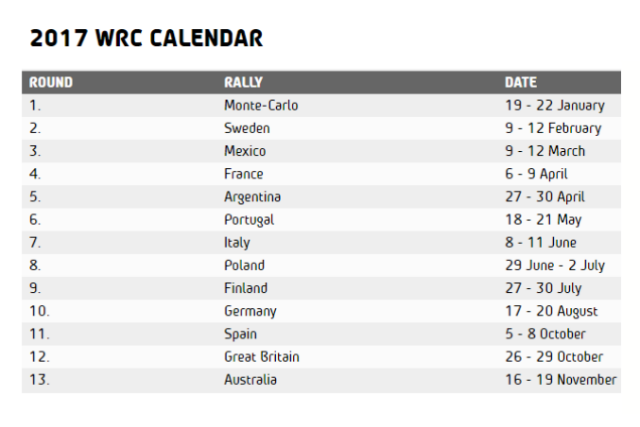
Next year’s season kicks off fairly soon, with the first event in the calendar being Rally Monte-Carlo, which takes place between the 19th and the 22nd of January.
The event will conclude with Rally GB as the penultimate rally in late October before things wrap up in Australia toward the middle of November.
For a full list of this year’s events and the dates, refer to the image above or keep updated via the official WRC website.
How do I watch it?
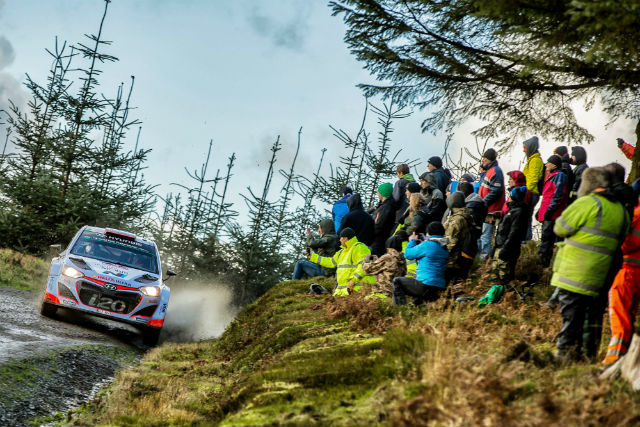
The WRC seriously stepped up its global broadcasting efforts this year, and as a result it’s never been easier to see the action. If you live in the UK, WRC highlights are aired on Channel 5, while you can also watch the full thing on BT Sport or catch up with the action on the WRC’s official YouTube channel.
Viewers sat at home will be further spoiled for choice this year with the introduction of live WRC coverage from Red Bull TV, which will broadcast the action live from the stages on Saturdays and also run highlights programmes on Fridays, Saturdays and Sundays.
Red Bull TV is free to watch and can be streamed online via mobile, laptop or smart TV, or alternatively there’s a dedicated app which is available for both iOS and Android.
However, anybody who’s been to see a rally event in the past will tell you that the only way to truly watch it is to actually go to one of the events and see the cars fly past mere feet from your face, blasting flames out the exhaust and spitting gravel in your face.
If you want to see one of the international events like the ever-popular Rally Finland, you can either travel to the country and make your way to each stage yourself or, alternatively, you can book package deals via sites like rallytravel which will include accommodation and all transportation to each stage of the rally.
If you want to catch Rally GB in your homeland, you can buy tickets to individual stages, or weekend tickets that allow you to watch from any spectator area and also visit the Rally Village to see the teams prepare the cars and meet the drivers.
For more family-friendly action, this year the WRC held a special RallyFest event at Cholmondeley Castle in Cheshire, which combines a full WRC timed stage with activities for families and children. Nothing has been confirmed yet, but given the popularity of 2016’s event, it’s likely something similar will return next year.
Predictions for who’s going to win?
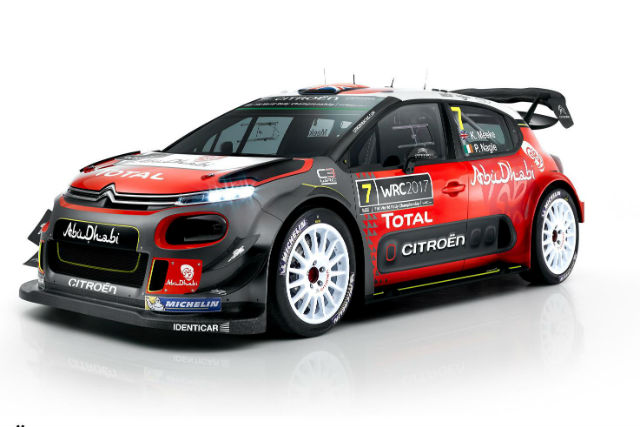
One of the most exciting things about the 2017 WRC season is that it’s really anybody’s guess as to who will win. All of the cars are completely new, and so it’s impossible to benchmark one against the other, while the new rosters of drivers means that star talent is now more evenly spread across all of the teams.
If you want our prediction, we reckon that 2017 will be the year for Northern Irishman Kris Meeke to finally shine. Meeke and Citroen took a year out during 2016 specifically to develop the next-gen C3 WRC, and so it’s Meeke who has spent the most time behind the wheel of his newest car.
Add to the fact that he set some stunning times in some of the most notoriously difficult rallies last year and we’d say Meeke will be in with a serious chance of taking the 2017 drivers’ championship.
However, Malcolm Wilson’s M-Sport is also hungry for success and has spent considerable time and resource developing its new Fiesta, as well as pulling a blinder by hiring Sebastien Ogier, who has won the title for the past four years in a row.
Ogier won’t have spent much time in the new Fiesta however and it may take some time for him to get to grips with it, particularly given that early events on the calendar like Monte Carlo and Sweden aren’t really representative rallies.
Still, given the talent of both Ogier and his two fellow drivers, we reckon that it could be M-Sport which takes the manufacturers’ title. Of course, the other teams and drivers aren’t to be underestimated, and at this stage it’s impossible to accurately predict the outcomes.
Sounds awesome!
Got to let my hair down today at VIP ride day and have some fun....this is what I love about rallying 😜 #sideways #fun #dust pic.twitter.com/nBq26Sut7a
— Hayden Paddon (@HaydenPaddon) November 21, 2016
It sure is. If you’re a newcomer to rallying or you’re not sure about the sport, why not check out some of the WRC’s highlights from previous championships below? We defy anybody to watch this and not be impressed:
